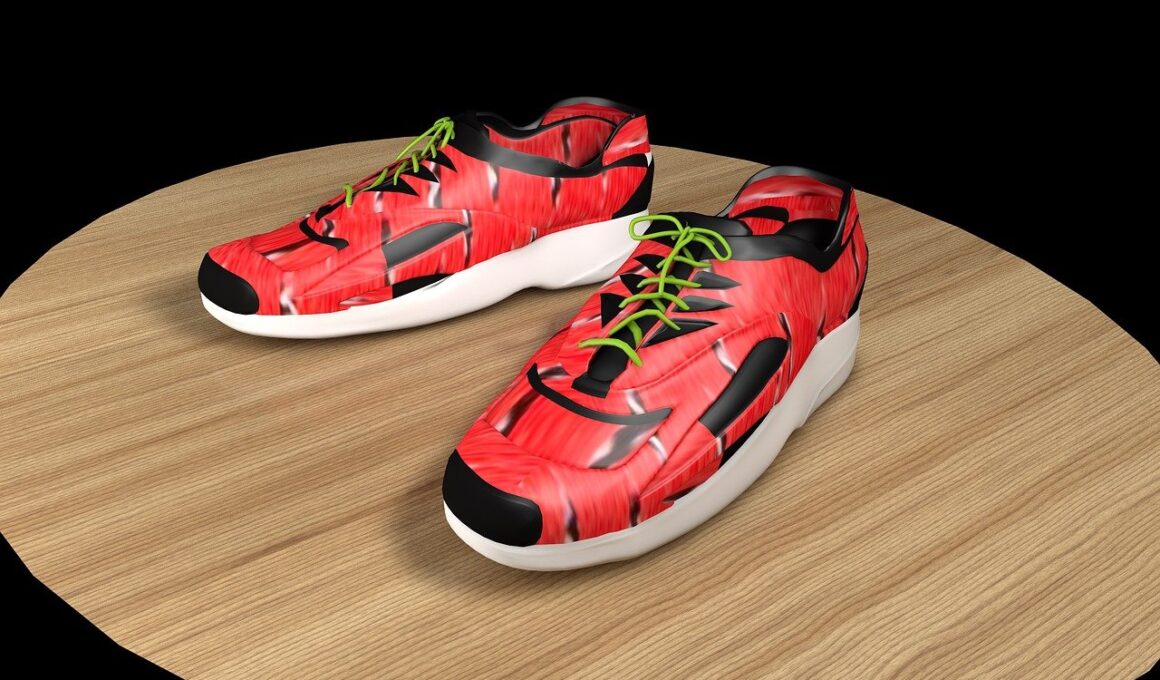Best Running Shoes for Trail Running: Durability and Traction
When it comes to trail running, selecting the right pair of shoes is crucial. The terrain varies greatly from rugged mountains to slippery mud, making durability and traction essential. Quality trail running shoes should provide excellent grip and stability on a variety of surfaces. Look for shoes with enhanced rubber outsoles designed specifically for traction on different terrains. Additionally, the upper material should be durable yet flexible, allowing for a comfortable fit. Many shoes now use rip-resistant materials that can stand up to rocks and branches. Moreover, consider features such as waterproofing; it keeps your feet dry during rainy conditions. A good cushioning system is necessary for shock absorption, protecting your joints and providing comfort during long runs. Don’t forget to check for breathability to keep your feet cool. Fit is paramount to prevent blisters, so trying on various brands to find the best pair for you is advisable. Research other runner’s experiences online, and assess materials used carefully. Thankfully, numerous brands now cater specifically to trail runners, offering various choices with varying features.
Key Features to Look For
Choosing trail running shoes requires attention to various key features. First, the sole’s traction is paramount. Look for aggressive tread patterns that ensure grip on uneven and slippery surfaces. Shoes should also have a sturdy toe cap to shield your feet from rocks and roots. Next, consider fit and flexibility; a snug fit prevents blisters during extended runs while allowing your foot to move naturally. Cushioning is another crucial factor; shoes must provide adequate support for prolonged trails while offering ground feel. Breathability also matters; a well-ventilated shoe will help regulate temperature and wick moisture away. Another important consideration is weight; lightweight shoes can enhance speed, but robust materials are essential for longevity. Remember, waterproofing may sometimes come with trade-offs; while it keeps feet dry, it can also affect breathability. Test different brands and styles to discover what suits your running style and foot shape best. Price varies significantly based on brand and features, so set a budget without compromising on essential qualities. Finding the perfect balance between durability, comfort, and performance is key for enjoyable trails ahead.
Popular brands in the running shoe market offer excellent options for trail runners. Brands like Salomon, Merrell, and Brooks have built reputations for delivering high-quality trail footwear. Salomon’s Speedcross series is particularly favored for its exceptional traction and lightweight design. Merrell offers models that blend comfort and durability, perfect for longer excursions. Brooks, known for cushioned shoes, provides trail-ready options that still maintain their supportive qualities. Newer brands like Altra and Hoka One One are making waves, focusing on maximalist cushioning and unique designs. It’s worth noting that personal preference is crucial; what works for one person may not work for another. Online reviews can provide insights into the features of each shoe, but trying them on remains important. Look for local running shops where experts can assist in fitting. Some stores even allow you to test shoes on a treadmill or track, which can significantly help in decision-making. Many brands frequently update their models, so staying informed about their latest releases can offer exciting new choices.
Testing Your Trails
Before committing to a specific pair of trail shoes, it’s ideal to conduct field tests. Take them on shorter runs in environments similar to your usual trails. This way, you can assess the fit, comfort, and performance during actual running conditions. Shoes may feel different on the road than on rocky or muddy trails, which is crucial to determine beforehand. Pay close attention to how well the shoe grips on various surfaces; ensure it isn’t overly stiff or too soft, affecting stability. Run through water or muddy paths to evaluate waterproofing features, as well. This real-world testing will help pinpoint any discomfort, allowing you to adjust or exchange before embarking on longer excursions. Don’t hesitate to switch out insoles if the stock option doesn’t meet your comfort level. Take note of any blisters or pressure points; the right shoe should feel natural from the start. Use this testing period to find the ideal pair that meets your needs holistically. Your feet will thank you once you hit the trails.
When selecting trail running shoes, take your foot type into account. Recognizing whether you have a neutral foot, overpronation, or supination will dramatically influence your choice. Most brands offer shoes tailored to specific foot types, enhancing comfort and performance. Over time, your foot architecture may change, especially if you engage in a lot of running. It’s essential to have your feet measured frequently and reassess your footwear needs. In addition, consider any existing injuries that may impact your choice of footwear. Those with pronation issues might benefit from additional stability features or structured support. Stretching and strength training for the foot can also augment running performance and prevent injuries. It’s prudent to listen to your body while running; any persistent pain or discomfort should prompt a reevaluation of your shoes. Consulting with a specialist at a running store can yield valuable feedback. Networking with fellow trail runners can provide anecdotes about their footwear experiences. Ultimately, choosing the right shoes can enhance your running experience significantly.
Conclusion
In conclusion, finding the best trail running shoes requires a careful mix of research, testing, and personal preference. Prioritize durability and traction as you explore various styles and brands in the market. Take ample time to assess the features and how they align with your running habits. A well-made pair of shoes can make all the difference, especially when tackling challenging terrains. Avoid rushing into a purchase; instead, be thorough with your evaluations. Remember to factor in your local running conditions, the intended use of the shoes, and your unique foot shape. Visit local stores, engage with knowledgeable staff, and seek recommendations from the running community. Online resources can enhance your knowledge about specific products, but personal trials are invaluable. As trends in footwear continue to evolve, keeping up with innovations can lead to more comfortable and effective running experiences. Your passion for trail running deserves to be supported by equipment that performs excellently on rugged paths. Enjoy the journey of finding your perfect match, and happy running!
Taking care of your trail running shoes will ensure their longevity and performance. Regular cleaning to remove dirt and grit can significantly impact the shoe’s materials over time. Additionally, drying shoes properly is vital, especially after wet runs; leaving them in a well-ventilated area prevents mold and odors. Check the outsole regularly for signs of wear and tear, and replace shoes according to mileage or visible degradation. Keeping an eye on both cushioning and tread patterns can provide necessary insights into when to buy a replacement. When you notice more slips or discomfort during your runs, it may be time to consider new footwear. Using two pairs alternately can extend the life of each pair, allowing them to decompress between runs. Invest in proper shoe storage to protect them from environmental factors when not in use. Some runners even choose to rotate between trail shoes and road shoes, depending on the surface they plan to run on. This switch can significantly improve comfort and performance while ensuring that each shoe type is optimal for its dedicated terrain. Always listen to your body and monitor how your shoes feel during your outings. Proper care leads to effective training.
Explore Your Options
To summarize, emphasize comprehensively researching and testing your options when in search of the best trail running shoes. They must align with your foot type, running style, and the unique terrain you’ll navigate. Performance-enhancing features such as cushioning, traction, and durability play pivotal roles. Visit local shops that facilitate trials, and consider recommendations from friends or running groups. Online reviews can provide additional perspectives on various models, while informative articles can guide your decision-making. Don’t hesitate to take notes during your shoe testing process to help with your choice. Quality footwear is crucial for safety and enhancing your overall trail experience. Expect adjustments as new technologies emerge, and more brands enter the trail running market. The perfect shoe should inspire confidence on your runs. Make educated decisions, and let comfort drive your choices. Your feet are the foundation of your running journey; invest in them wisely to maximize enjoyment and minimize injury, ensuring that each trail run becomes an unforgettable adventure. Embrace the journey of selecting trail shoes that enhance your performance and promote happiness during your outdoor escapades.


